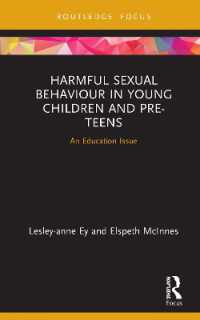- ホーム
- > 洋書
- > 英文書
- > Literary Criticism
Full Description
George C. Manning examines the presentation of anger in the Íslendingasögur ('Sagas of Icelanders') and associated Íslendingaþættir ('Tales of Icelanders'), a remarkable Old Norse-Icelandic corpus of texts written down in the thirteenth and fourteenth centuries that detail conflicts and feuds of Icelanders during the late-ninth, tenth, and early-eleventh centuries. It first shows how various unqualified involuntary somatic responses, facial expressions, and bodily movements frequently indicate angry experience in the sagas, before arguing that anger's mode of expression is contingent on a character's sociocultural identity. Through close analysis of how five groups of characters--men, women, elderly men, berserkir (raging warriors), and sovereign figures--exhibit anger, the book demonstrates that these different character groups experience and express emotion in different ways, in accordance with strict social rules: they adhere to different 'emotive scripts', to use Sif Ríkharðsdóttir's term. Importantly, the book shows, through analysis of how these identities experience anger, that emotions institute and uphold gender configurations; its primary focus, therefore, is the nexus between anger and gender.
Manning argues that anger is seen as a weakness for most male characters, while female characters, elderly men, berserkir, and sovereign figures can exhibit anger without opprobrium and often use it to their advantage. It demonstrates how anger plays a key role in establishing (or resolving) narrative tensions in the sagas and deepens our understanding of the Old Norse-Icelandic terms that saga-authors use to communicate anger. The work--the first book-length investigation of anger in the Sagas of Icelanders--thus functions as a major intervention into the fields of both emotion and gender studies in medieval literature.
Contents
1: Introduction
Part I. 'Ferreting Out' Anger
2: 'Ferreting Out' Anger from Involuntary Psychosomatic Indicia
3: 'Ferreting Out' Anger from Facial and Bodily Expressions
Part II. Anger and Masculinities
4: Anger and Hegemonic Masculinity
5: Anger and Female Masculinity
Part III. Anger and Other Identities
6: Anger and Old Age
7: Anger and Berserkir
8: Anger and Sovereignty
9: Conclusion








